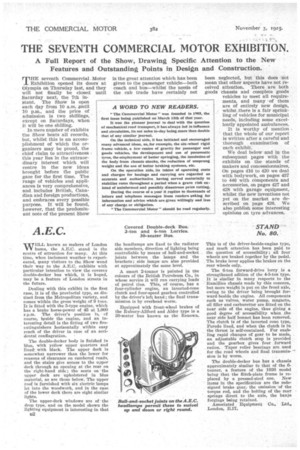W ELL known as makers of London buses, the A.E.C. stand
Page 8

If you've noticed an error in this article please click here to report it so we can fix it.
is the centre of attraction for many. At this time, when inclement weather is experienced, many visitors to the Show wend their way to the A.E.C. exhibits with particular intention to view the coverea double-decker bus which, it is hoped, may be a feature of London streets in the future.
Dealing with this exhibit in the first case, it is of the provincial type, as distinct from the Metropolitan variety, and comes within the gross weight of 9 tons. It is fitted with the 6-type engine, which has a brake horse-power of 45 at 1,000 r.p.m. The driver's position is, of course, beside the engine, and an interesting detail is the fitting of two fireextinguishers horizontally within easy reach of the driver in case of an acci dental conflagration. '
The double-decker body is finished in blue, with yellow upper quarters and lined._ with black. The upper deck is somewhat narrower than the lower for reasons of clearance on cambered roads, and the stairs give access to the upper deck through an opening at the rear on the right-hand side ; the seats on -the upper deck are upholstered in blue material, as are those below. The upper roof is furnished with six electric lamps let into the woodwork, and in the case of the lower deck there are eight similar lights.
The upper-deck windows are of' the drop type, and on the model shown the lighting equipment is interesting in that D2
the headlamps are fixed to the radiator side members, direction of lighting being controllable by means of ball-and-socket joints between the lamps and the brackets; side lamps are also provided at approximately the same level.
A smart 2-tonner is painted in the colours of the British Petroleum Co., in whose service it will run carrying loads of petrol tins. This, of• course, has a four-cylinder engine, an inverted-cone clutch and four-speed gearbox controlled by the driver's left band ; the final transmission is by overhead worm.
Equipped with front-wheel brakes of the Rubury-Allford and Alder type is a 30-seater bus known as the Renown. This is of the driver-beside-engine type, and much attention has been paid to the question of accessibility ; all four wheels are braked together by the pedal. The brake lever applies the brakes on the rear wheels only.
The 6-ton forward-drive lorry is a strengthened edition of the 4-5-ton type. It is similar in many respects to the Ramillies chassis made by this concern, but more weight is put on the front aide, owing to the driver being brought f orward .beside the engine. All components such as valves, water pump, magneto, oil filler and carburetter are fitted on the near side of the engine, thus giving a good degree of accessibility when the near side half bonnet has been removed. The clutch is of the inverted cone type, Ferodo lined, and when the dutch is in the thrust is self-contained. For enabling rapid changes of gear to be made, an adjustable clutch stop is provided and the gearbox gives four forward ratios. Taper roller bearings are used for the road wheels and final transmission is by worm.
The double-decker bus has a chassis approximately similar to that of the 6tonner, a feature of the 1926 model being that the flitch-plate frame is replaced by a pressed-steel one. New items in the specification are the redesigned brake gear, the omission of the torque rod, and the bolting of the rear springs direct to the axle, the banjo forgings being retained.
Associated Equipment Co., Ltd., London, E.17.
















































































